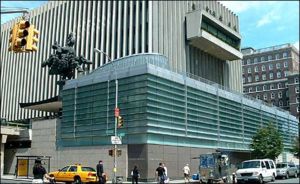Difference between revisions of "Jerome Greene Hall"
(→Revision and renovation) |
Absentminded (talk | contribs) |
||
| Line 1: | Line 1: | ||
[[Image:JeromeGreene.jpg|thumb|300px|Jerome Greene Hall]] | [[Image:JeromeGreene.jpg|thumb|300px|Jerome Greene Hall]] | ||
| − | '''Jerome Greene Hall''' (sometimes referred to simply as '''Greene''') is the primary home of [[Columbia Law School]] and is one of Columbia | + | '''Jerome Greene Hall''' (sometimes referred to simply as '''Greene''') is the primary home of [[Columbia Law School]] and is one of a number of buildings put up in succession by Columbia in the 1960s. It is named after wealthy alumnus [[Jerome L. Greene]]. Often criticized as being ugly by outsiders, law students have been known to develop a certain fondness for the building. |
==History== | ==History== | ||
| Line 7: | Line 7: | ||
===Planning=== | ===Planning=== | ||
| − | In the 1960s, Columbia was expanding the size and resources of its graduate professional schools. Among these, the law school, squeezed into the elegant but cramped [[Kent Hall]], required a new home. Hence Greene, along with [[Uris]] for the [[Business School]], [[Mudd]] for the [[SEAS|Engineering School]], and [[IAB]] for [[SIPA]], was built with donor money solicited by the deans of the respective schools around this time. | + | In the 1960s, Columbia was expanding the size and resources of its graduate professional schools. Among these, the law school, squeezed into the elegant but cramped [[Kent Hall]], required a new home. Hence Greene, along with [[Uris]] for the [[Business School]], [[Mudd]] for the [[SEAS|Engineering School]], and [[IAB]] for [[SIPA]], was built with donor money solicited by the deans of the respective schools around this time. It has been argued that the primary aims of each dean and donor was to build the most cost-efficient and practical building for the school- and therefore aesthetics weren't really all that important. |
===Design=== | ===Design=== | ||
Revision as of 23:28, 19 November 2007
Jerome Greene Hall (sometimes referred to simply as Greene) is the primary home of Columbia Law School and is one of a number of buildings put up in succession by Columbia in the 1960s. It is named after wealthy alumnus Jerome L. Greene. Often criticized as being ugly by outsiders, law students have been known to develop a certain fondness for the building.
History
Planning
In the 1960s, Columbia was expanding the size and resources of its graduate professional schools. Among these, the law school, squeezed into the elegant but cramped Kent Hall, required a new home. Hence Greene, along with Uris for the Business School, Mudd for the Engineering School, and IAB for SIPA, was built with donor money solicited by the deans of the respective schools around this time. It has been argued that the primary aims of each dean and donor was to build the most cost-efficient and practical building for the school- and therefore aesthetics weren't really all that important.
Design
The building was designed by GSAPP alum Max Abramovitz of the firm Harrison and Abramovitz, better known for their work on Lincoln Center. The window boxes on the two narrow ends of the building, often described as being fit for a Mussolini-esque dictator to salute the masses, have earned the building its nickname of "the toaster." The building opened in the fall of 1961, and a mural recognizing donors for the building is on the western wall of the main lobby.
Revision and renovation
The building's western facade is graced by Jacques Lipschitz's sculpture Bellerophon Taming Pegasus, donated in 1977. The sculpture is said to represent the experience CLS 1Ls endure.
In the late 1990s the Jerome Greene underwent a major renovation, resulting the construction of the new entrance, lounges, and cafeteria, Lenfest Cafe, in an addition fronting on the intersection of 116th and Amsterdam. This was followed by gut renovations of the building's classrooms and offices. In 2007, construction began on the addition of a 9th floor for the building.
Pictures
Lenfest Cafe, a dining services location in Greene






